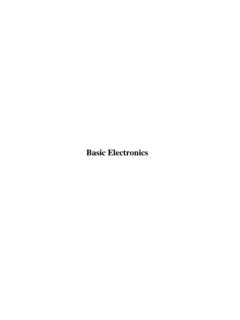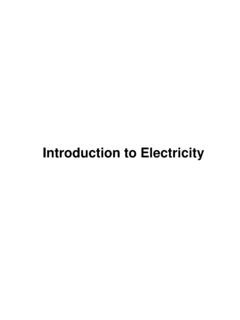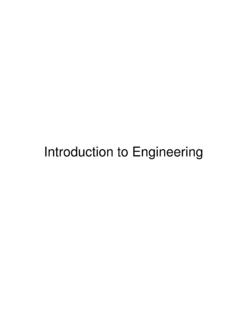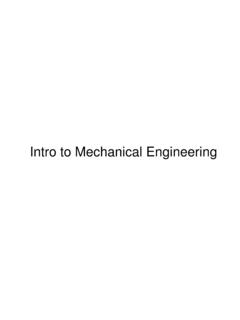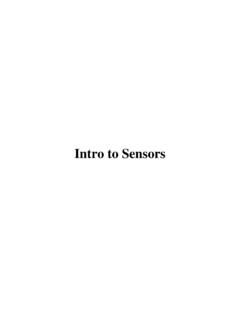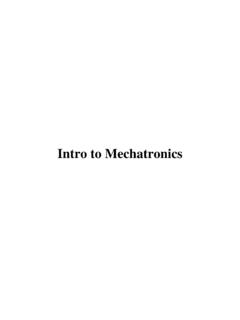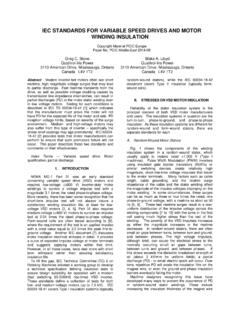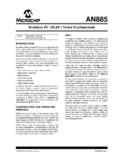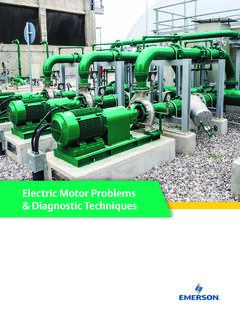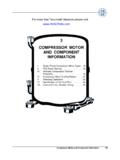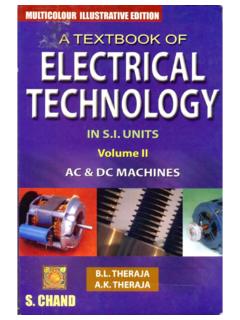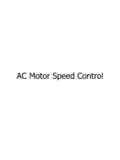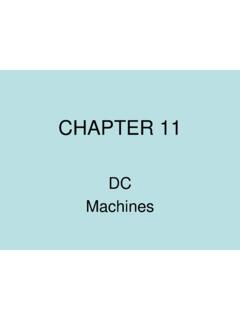Transcription of Brushless DC Motors
1 Actuators & Sensors in Mechatronics: Brushless DC MotorsK. Craig1 Brushless Direct-Current Motors Features Common to Rotating Magnetic Field Electromechanical Devices Introduction Windings Air Gap mmf Sinusoidally-Distributed Windings Rotating Air Gap mmf Two-Pole Devices Introduction to Several Electromechanical Motion Devices Reluctance Devices Induction MachinesActuators & Sensors in Mechatronics: Brushless DC MotorsK. Craig2 Synchronous Machines Permanent-Magnet Devices Brushless DC Motors Introduction Two-Phase Permanent-Magnet Synchronous Machine Voltage Equations and winding Inductances Torque Machine Equations in the Rotor Reference Frame Time-Domain Block Diagrams and State EquationsActuators & Sensors in Mechatronics: Brushless DC MotorsK. Craig3 Features Common to Rotating Magnetic Field Electromechanical Devices Introduction A dc machine has windings on both the stationary and rotating members, and these circuits are in relative motion whenever the armature (rotor) rotates.
2 However, due to the action of the commutator, the resultant mmf produced by currents flowing in the rotor windings is stationary. The rotor windings appear to be stationary, magnetically. With constant current in the field (stator) winding , torque is produced and rotation results owing to the force established to align two stationary, orthogonal magnetic & Sensors in Mechatronics: Brushless DC MotorsK. Craig4 In rotational electromechanical devices other than dcmachines, torque is produced as a result of one or more magnetic fields which rotate about the air gap of the device. Reluctance machines, induction machines, synchronous machines, stepper Motors , and Brushless dc Motors (permanent-magnet synchronous machines), all develop torque in this manner. There are features of these devices which are common to all, in particular: winding arrangement of the stator Method of producing a rotating magnetic field due to stator currents Hence, we cover these common features & Sensors in Mechatronics: Brushless DC MotorsK.
3 Craig5 Windings Consider the diagram of the elementary two-pole, single-phase stator winding . winding asis assumed distributed in slots over the inner circumference of the stator, which is more characteristic of the stator winding than is a concentrated winding . The winding is depicted as a series of individual coils. Each coil is placed in a slot in the stator steel. Follow the path of positive current iasflowing in the aswinding. Note that as1and as1 are placed in stator slots which span radians; this is characteristic of a two-pole machine. as1around to as1 is referred to as a coil; as1or as1 is a coil side. In practice a coil will contain more than one & Sensors in Mechatronics: Brushless DC MotorsK. Craig6 The number of conductors in a coil side tells us the number of turns in this coil. This number is denoted asncs. Repeat this winding process to form the as2 as2 coil and the as3 as3 coil, assuming that the same number of turns, ncs, make up each coil.
4 With the same number of turns in each of these coils, the winding is said to be distributed over a span from as1to as3or 60 . The right-hand rule is used to give meaning to the asaxis; it is the principal direction of magnetic flux established by positive current flowing in the aswinding. It is said to denote the positive direction of the magnetic axis of & Sensors in Mechatronics: Brushless DC MotorsK. Craig7 Elementary Two-Pole, Single-Phase Stator WindingActuators & Sensors in Mechatronics: Brushless DC MotorsK. Craig8 Now, consider the diagram of the elementary two-pole, two-phase stator windings. Here we have added a second winding the bs winding . The magnetic axis of the bswinding is displaced from that of the aswinding. Assume that the positive direction of ibsis such that the positive magnetic axis of the bswinding is at s= where sis the angular displacement about the stator referenced to the asaxis. This is the stator configuration for a two-pole, two-phase electromechanical device.
5 The stator windings are said to be symmetrical(as it is used in electromechanical devices) if the number of turns per coil and resistance of the asand bswindings are & Sensors in Mechatronics: Brushless DC MotorsK. Craig9 For a two-pole, three-phase, symmetrical electromechanical device, there are three identical stator windings displaced 120 from each other. Essentially all multiphase electromechanical devices are equipped with symmetrical & Sensors in Mechatronics: Brushless DC MotorsK. Craig10 Elementary Two-Pole, Two-Phase Stator WindingsActuators & Sensors in Mechatronics: Brushless DC MotorsK. Craig11 Air Gap mmf Sinusoidally-Distributed Windings It is generally assumedthat the stator windings (and in many cases the rotor windings) may be approximatedas sinusoidally-distributed windings. The distribution of a stator phase winding may be approximated as a sinusoidal function of s, and the waveform of the resulting mmf dropped across the air gap (air gap mmf) of the device may also be approximated as a sinusoidal function of s.
6 To establish a truly sinusoidal air gap mmf, the winding must also be distributed sinusoidally, and it is typically assumed that all windings may be approximated as sinusoidally-distributed & Sensors in Mechatronics: Brushless DC MotorsK. Craig12 In the figure, we have added a few coils to the aswinding, which now span 120 . For the purpose of establishing an expression for the air gap mmf, we employ the developed diagram of the cross-sectional view obtained by flattening out the rotor and stator. Note that displacement sis defined to the left of the asaxis since this allows us to position the stator above the rotor. The winding distributions may be approximated as: Npis the peak turns density in for 0 NNsin for 2= < < = < < Actuators & Sensors in Mechatronics: Brushless DC MotorsK. Craig13 If Nsrepresents the number of turns of the equivalent sinusoidally distributed winding (not the total turns of the winding ) that corresponds to the fundamental component of the actual winding distribution, then: The sinusoidally-distributed winding will produce a mmf that is positive in the direction of the asaxis (to the right in the figure for positive ias).
7 We assume that all of the mmf is dropped across the air gap, as the reluctance of the steel is much smaller (neglecting saturation) than the reluctance of the air gap. So if the windings are sinusoidally-distributed in space, then the mmf dropped across the air gap will also be sinusoidal in space.()spssp0 NNsind2N = = Actuators & Sensors in Mechatronics: Brushless DC MotorsK. Craig14 Approximate Sinusoidal Distribution of the asWindingActuators & Sensors in Mechatronics: Brushless DC MotorsK. Craig15 Developed Diagram withSinusoidally-Distributed Stator WindingStatorRotorActuators & Sensors in Mechatronics: Brushless DC MotorsK. Craig16 We need to develop an expression for the air gap mmf, mmfas, associated with the aswinding. We will apply Ampere s Law to two closed paths, shown in the diagram. For closed path (a), the total current enclosed is Nsiasand, by Ampere s Law, this is equal to the mmf drop around the given path ( ). If the reluctance of the rotor and stator steel is small compared with the air-gap reluctance, we can assume that of the mmf is dropped across the air gap at s= 0 and at s=.
8 By definition mmfasis positive for a mmf drop across the air gap from the rotor to the stator. Thus mmfasis positive at s= 0 and negative at s= , assuming positive uruurg Actuators & Sensors in Mechatronics: Brushless DC MotorsK. Craig17 This suggests that for arbitrary s, mmfasmight be expressed as: This tells that the air gap mmf is zero at s= . Check this by applying Ampere s Law to the second closed path in the figure, path (b). The net current enclosed is zero, and so the mmf drop is zero along the given path, implying that mmfas= 0 at s= .sasassNmmficos2= ()()sasassasasNmmf0i2 Nmmfi2= = Actuators & Sensors in Mechatronics: Brushless DC MotorsK. Craig18 Let s consider the bswinding of a two-phase device. The air gap mmf due to a sinusoidally-distributed bswinding may be expressed as:sbsbssNmmfisin2= Actuators & Sensors in Mechatronics: Brushless DC MotorsK. Craig19 Closed Paths used to Establish mmfasActuators & Sensors in Mechatronics: Brushless DC MotorsK.
9 Craig20A mmfasDue to Sinusoidally Distributed asWindingActuators & Sensors in Mechatronics: Brushless DC MotorsK. Craig21 Rotating Air Gap mmf Two-Pole Devices Considerable insight into the operation of electromechanical motion devices can be gained from an analysis of the air gap mmf produced by current flowing in the stator winding (s). Let s consider the rotating air gap mmf s produced by currents flowing in the stator windings of single-, two-, and three-phase & Sensors in Mechatronics: Brushless DC MotorsK. Craig22 Single-Phase Devices Consider the device shown which illustrates a single-phase stator winding . Assume the aswinding is sinusoidally distributed, with asand as placed at the point of maximum turns density. Assume that the current flowing in the aswinding is a constant. Then the aswinding would establish a stationary magnetic system with a N pole from < s< and a S pole from < s< . The air gap mmf is directly related to these poles; indeed, the flux flowing from the N pole and into the S pole is caused by the air gap & Sensors in Mechatronics: Brushless DC MotorsK.
10 Craig23 Elementary Two-Pole, Single-Phase Sinusoidally-Distributed Stator WindingActuators & Sensors in Mechatronics: Brushless DC MotorsK. Craig24 What happens when the current flowing in the aswinding is a sinusoidal function of time? Let s assume steady-state operation: Capital letters denote steady-state instantaneous variables; Isis the rms value of the current; eis the electrical angular velocity; esi(0) is the angular position corresponding to the time zero value of the instantaneous current. The air gap mmf expressed for the aswinding is:()asseesiI2 Icost0 = + ()ssasassseesisNNmmficos2 Icost0cos22 = = + Actuators & Sensors in Mechatronics: Brushless DC MotorsK. Craig25 Consider this expression for a moment. It appears that all we have here is a stationary, pulsating magnetic field. Let us rewrite this expression using a trig identity: The arguments of the cosine terms are functions of time and displacement s. If we can make an argument constant, then the cosine of this argument would be constant.
